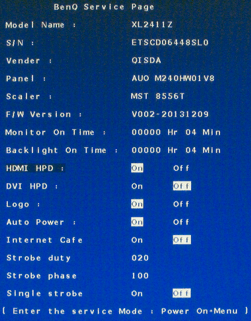Reduces motion blur by a factor of 6 8 Accustomed Actions Measuring matrices 8.2
- Diablo 2 Best Act 2 Merc For Sorc Eress Guide, What is The Best Merc For Fire/Cold Sorc?
- 16 Of The Best Christmas Board Books For Babies And Toddlers
- How My Best Brings Out The Best In Others Quotes, Top 21 Bringing Out The Best Quotes
- The 10 Best Restaurants Chester County Pa, Restaurants
- TF2 Scout Cosmetic Loadouts: What’s The Best Scout Loadout TF2? Best Scout Weapons TF2
Specifications
| BenQ |
| XL2411Z |
| 24″ |
| 1920×1080 |
| TN |
| 144 Hz |
| M240HW01 V8 AUO |
| Type 8556T (MSTAR) |
| Bright White Edge-Lit LED |
| There is only one source of power, and its designation is MP3398 (Monolithic Power). |
| USD 300 |
| 12/2013 |
Comparison with other LCDs
BenQ’s answer to 2D LightBoost is called Motion Blur Reduction, and it’s available on the BenQ XL2411Z in addition to the BenQ XL2411T. Keep in mind that the Z-series monitors still support NVIDIA’s 3D LightBoost, but the Strobelight Utility, which enabled 2D LightBoost and worked with AMD graphics cards, is incompatible with the Z-series monitors. LightBoost can still be used in 2D, but only if the NVIDIA 3D VISION hardware and software are installed and activated.
While Motion Blur Reduction works with refresh rates as high as 144 hertz, LightBoost is limited to 100 hertz and 120 hertz.
The XL2411Z is very similar to the XL2420Z in terms of picture quality. The only real differences between the two are the XL2420Z’s fancier design, included remote control (not wireless), and expanded inputs (DisplayPort, second HDMI, USB).

Menu de servicios BenQ XL2411Z
Hook up the screen to a reliable signal source. To access the service menu, power on the screen while holding down the second button from the left (the “down” button). When the service menu is enabled or disabled, it can be accessed by pressing the fourth button from the left (“menu” button). To access the OSD menu, first hide the service menu by pressing any button other than “menu,” and then look up to see if any icons have appeared above the buttons. In that case, you can access the OSD menu by pressing the “menu” button. After a reboot, the “menu” button will function normally again.
Firmware
Xem thêm : Best Weapons For Excalibur Warframe, Best Melee Weapon For Excalibur
First in the industry, BenQ’s Z-series monitors are upgradeable via firmware. Initial releases of these screens used firmware with a less-than-ideal implementation of Motion Blur Reduction. As a result, BenQ is encouraging its customers to send in their monitors for an upgrade, or allowing enthusiasts to perform the upgrade themselves (with the caveat that they will need additional programming hardware to do so). For detailed guidance on upgrading, consult BlurBuster’s documentation. BenQ’s firmware download page is not kept up to date, unfortunately. Midway through 2015, manufacturers began shipping monitors with firmware version 4, which boasted enhanced overdrive functionality for use with Motion Blur Reduction. Still, firmware versions 2 and 4 are identical with respect to the flicker-free mode. All of the following data was collected using version 2.
Although the XL2411Z is nearly identical to the XL2411T, a BenQ XL2411T will not function properly after being upgraded to the Z-version firmware (see below, Accessing the backlight signals).
Motion Blur Reduction (MBR)
BenQ offers an alternative to 2D LightBoost called Motion Blur Reduction (MBR for short). Similar to LightBoost, MBR will flash the backlight once every refresh. Unlike LightBoost, it does not modify the update timing of the LC panels or use different overdrive parameters for the various pixel lines, both of which are known to negatively impact settling behavior. In other words, LightBoost has a better shot at success.
Easily recognizable MBR characteristics
However, with firmware version v2 installed, BenQ provides more customization options for MBR. Along with enabling MBR outside of the standard 100 Hz and 120 Hz range, without the need for dedicated NVIDIA graphics hardware, users are also given granular control over backlight pulse parameters such as pulse width and pulse phase in relation to VSync. Either through the service menu (parameters strobe duty and strobe phase) or BlurBuster”s Strobe Utility or through direct DDC/CI programming (Display Data Channel/Command Interface). If the LC panel update is sped up by adjusting the monitor timing, adjusting the pulse parameters becomes especially useful.
Pulse width of the backlight
Average Median Medial
| Power Booster Lights 100 Hertz | 1.88 | 3 |
| LightAmplifier 120 Hz | 1.4 | 2.25 |
| MBR 60 Hz | 0.17 | 5 |
| MBR 100 Hz | 0.1 | 3 |
| MBR 120 Hz | 0.08 | 2.5 |
| MBR 144 Hz | 0.07 | 2.1 |
Xem thêm : Dark Souls 2 Best Scythe – The Best Reapers In Dark Souls Ii (All 9, Ranked)
In order to make up for the time the LEDs are off between pulses when strobed backlight is used, whether for LightBoost or MBR, the current through the backlight LEDs is increased by a factor of about 1.8.
Within the range shown in the table, the pulse width can be linearly adjusted in either 10 discrete steps (LightBoost) or 30 discrete steps (MBR). In MBR mode, the pulse phase can also be adjusted; doing so allows for finer control over when the backlight pulse begins and ends relative to the update of the first pixel line. With a maximum of 100, this indicates that the pulse onset can be set at any time during the refresh cycle. This is not the case, however, because the pulse phase can only be set so that the pulse offset (not onset!) occurs just before the first pixel line is updated. Therefore, the first pixel line update must happen either before or after the backlight pulse, and never during.
Keeping an eye on (and adjusting) timing is essential.
To increase the frequency with which the LC display is updated, it is possible to adjust the timing of the monitor. According to the manual for the aforementioned BlurBuster”s Strobe Utility, this is accomplished by virtually extending the vertical synchronization phase while maintaining the vertical refresh rate. It has been empirically determined that the maximum possible number of vertical lines is 1 350 at a frequency of 120 Hz, and 1 500 at a frequency of 100 Hz. With the line and pixel clock frequencies being pushed to their limits by these timing modes, it may be beneficial to reduce the total number of pixel columns from 2080 to 2020. Different sync polarities and within-sync timing values (back porch, front porch, sync duration) may be needed to get the monitor to accept the unconventional timing, depending on the graphics card. It is still unclear whether or not the sync timings have any bearing on the image quality. However, it should be noted that the monitor will automatically switch to the 60 Hz backlight pulse widths whenever the timing deviates too far from any standard timing, as is clearly the case for the timings mentioned here. Since this affords the freedom to select pulse durations that could reduce the LEDs’ useful lifetime, it raises some concerns. For instance, if the pulse width is set to 5 ms at 120 Hz, which is the maximum for 60 Hz but pushes the average LED current at 120 Hz well beyond the limit considered safe by the manufacturer, then the average LED current is unsafe. Furthermore, if the value for the pulse phase is too high, the modified monitor timings may not work at all (i.e., black screen). Don’t just wing it; you need to know what you’re doing! If for some reason the monitor won’t go back to normal operation after going black, you may need to power it down, unplug it from the wall outlet and the computer, let it sit for a while to discharge (trying to turn it on while disconnected can help), and then reconnect it to disable MBR mode.
Interestingly, the latency experienced by the LC panel during updates or when the OpenGL SwapBuffers();glFinish() function sequence is being executed does not appear to be affected by the within-sync timing. At least with the tried and true NVidia driver and hardware, this is the case, but it is not neccessarily so. That said, the results could vary depending on the graphics driver version used or the hardware in question.
AMR and MBR
It is important to exercise caution when adjusting the AMA setting just before entering MBR mode, as this is BenQ’s implementation of overdrive. Actually, there are two additional, secret AMA settings, “MBR/High” and “MBR/Premium,” which modify the internal overdrive parameters in accordance with AMA=”High” and AMA=”Premium” respectively, during MBR activation. However, when in MBR mode and modifying the AMA setting, the overdrive parameters tailored to MBR (i.e., according to “MBR/High” or “MBR/Premium”) are replaced by the default values (i.e., “High” or “Premium”) for non-MBR mode. With the exception of AMA=off, which always results in overdrive being shut off, the order in which AMA and MBR mode are set and enabled matters.
Nguồn: https://directmarketingcenter.net
Danh mục: Best









